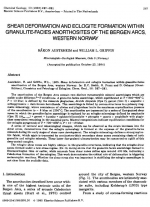Добрый день, Коллеги. Важное сообщение, просьба принять участие. Музей Ферсмана ищет помощь для реставрационных работ в помещении. Подробности по ссылке
Shear deformation and eclogite formation within granulite-facies anorthosites of the bergen arcs, Western Norway
Austrheim, H. and Griffin, W.L., 1985. Shear deformation and eclogite formation within granulite-facies anorthosites of the Bergen Arcs, western Norway. In: D.C. Smith, G. Franz and D. Gebauer (Guest-Editors), Chemistry and Petrology of Eciogites. Chem. Geol., 50: 267—281.
The anorthosites of the Bergen Arcs contain two distinct metamorphic mineral assemblages which are stable under different P—T conditions. A granulite-facies assemblage, which equilibrated at T = 800—900° C, P < 10 kbar, is defined by the minerals plagioclase, Al-rich diopside (Cpx I), garnet (Gnt I) ± scapolite ± orthopyroxene + dark-brown hornblende. This assemblage is linked by corona structures to a primary mag-matic mineralogy, where coexistence of olivine and plagioclase limits the maximum crystallization pressure of the anorthosites to ~ 8 kbar at 1200°C. The anorthosites are transected by a series of fine-grained shear zones in which the granulite-facies assemblage is replaced by an eclogite mineralogy defined by omphacite (Cpx II) (Jd40_i0) + garnet + kyanite + epidote/clinozoisite + phengite + quartz ± amphibole with plagioclase sometimes remaining in the marginal parts. Mineral compositions indicate equilibration conditions for the eclogite paragenesis of Г = 700—800° С, Р = 16—19 kbar.
A series of textural and mineralogical changes, which can be observed as the strain increases into the shear zones, demonstrates that the eclogite mineralogy is formed at the expense of the granulite-facies minerals during the early stages of shear zone development. The eclogite mineralogy defines a strong mylon-itic fabric, which again is truncated by centimetres-thick secondary shear zones containing clasts of both granulite and eclogite minerals. These latter fine-grained ultramylonites may be connected to uplift of this deep-seated complex.
The eclogite shear zones are highly oblique to the granulite structures, indicating that the eclogite shear zones formed under a new stress-regime. Rb—Sr dating shows that the granulite-facies assemblage formed in Sveconorwegian time or earlier, while minerals from shear zones define ages around 400 Ma, indicating a Caledonian formation of the eciogites. This work demonstrates the critical role of deformation in triggering metamorphic reactions. Whether the shear stress also was important in stabilizing the eclogite assemblages is not clear from the available data.




